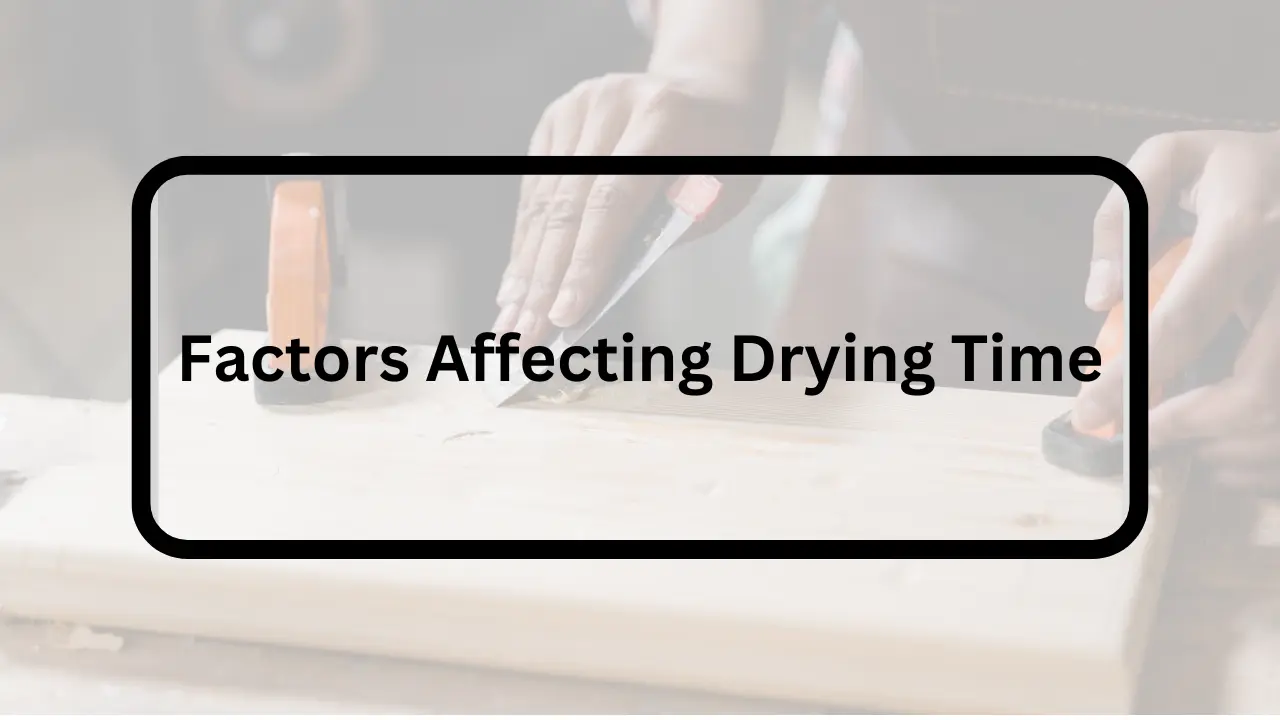How long for wood glue to dry? It’s a question every DIY enthusiast or woodworking aficionado asks at some point. Understanding the drying time of wood glue is crucial for project success. This guide is comprehensive. We’ll cover the factors that affect drying time for wood glue. These factors range from the glue type to the environment.
Whether you’re a beginner or a seasoned woodworker. This article will give valuable insights. They will help you make sure that you complete your projects with precision. By the end, you’ll know how long time for wood glue to dry. You’ll also get expert tips to speed it up when needed. Get ready to up your woodworking game. We will explore wood glue drying times in depth.
The Science Behind wood glue drying time

People often overlook wood glue drying time. But, it is a key part of woodworking. It bridges theory and practical skill. This brief exploration shows the science behind wood glue drying. We will demystify it. We study molecular interactions and environmental influences.
They unveil the complex mechanisms that control drying time. This sheds light on vital insights for both woodworking enthusiasts and professionals. Join us as we explain the hidden complexity of this key process. We will empower craftsmen with knowledge to improve their craft and get the best results.
Understanding the Chemistry
Wood glue, also known as carpenter’s glue or PVA glue, undergoes a chemical process known as polymerization when exposed to air. This process involves the bonding of individual molecules to form a strong, durable adhesive.
Types of Wood Glue
There are various types of wood glue available, including:
- PVA Glue: Most common and versatile.
- Polyurethane Glue: Offers water resistance and strong bonds.
- Hide Glue: Traditional and reversible.
Related Article: How to Clean Plywood Floors: Effortless Cleaning
Factors Affecting Drying Time

In woodworking, it’s key to understand the factors affecting time for wood glue to dry. This is especially true for wood glue. The question is “how long for wood glue to dry.” It gets at the heart of this inquiry. It covers variables like temperature, humidity, glue type, and wood species.
This exploration delves into the interplay of these factors. It sheds light on ideal conditions for making drying faster or slower. Understanding wood glue drying helps both craftsmen and manufacturers. It lets them improve techniques, ensure strength, and raise quality.
Ambient Temperature and Humidity
Several factors influence the drying time of a substance. Among them, temperature and humidity are key. Here’s how these factors affect drying time:
- Ambient Temperature:
- Higher temperatures generally speed up the drying process. This is because high temperatures increase evaporation. They let moisture escape from the material’s surface more quickly.
- Conversely, lower temperatures slow down drying. When its colder, evaporation requires less energy. This leads to a slower drying rate.
- Humidity:
- Humidity refers to the amount of moisture present in the air. High humidity hinders evaporation. Moisture saturates the air. So, it’s hard for material to dry.
- On the other hand, low humidity levels promote faster drying. In dry conditions, the air can absorb more moisture. This helps evaporation and so reduces drying time.
- Airflow:
- Airflow can significantly affect drying time. Air flows constantly. It helps carry away moisture from the material’s surface. This promotes faster drying.
- Stagnant air can do the opposite. It can slow drying by letting moisture collect around the material. This slows evaporation.
- Material Properties:
- The type and properties of the drying material are also crucial. They contribute to the process. Paper, fabric, and wood are porous materials. They absorb moisture more easily and take longer to dry than metal or glass, which are non-porous.
- Additionally, the thickness and density of the material can impact drying time. Thicker materials or ones with higher density may need more time. Moisture takes longer to evaporate from them.
- Surface Area:
- The surface area of the material exposed to the air influences drying time. Materials with larger surfaces dry more quickly. More moisture can evaporate from more points at once.
- Materials with smaller surface areas may take longer to dry. This is because there is less area for evaporation.
Understanding how these factors interact can help optimize drying processes. This applies to many industries, such as agriculture, manufacturing, and construction. Adjusting environmental conditions and other variables can help achieve desired drying outcomes efficiently.
Related Article: How to Remove Paint from Hardwood Floors
drying time for wood glue
Wood glue is a key adhesive in woodworking. It bonds wood pieces to make strong structures. However, one crucial aspect to consider when working with wood glue is its drying time. The time wood glue takes to dry matters a lot. It can affect project efficiency and success.
It affects factors like assembly time, clamping duration, and the project timeline. In this introduction, we delve into the factors that affect wood glue drying time. We provide insights into how to optimize this crucial process for woodworking.
Drying Times for Common Wood Glues
- PVA (Polyvinyl Acetate) Glue:
- Typically dries within 30 minutes to 1 hour.
- Full cure may take 24 hours or more, depending on factors such as humidity and temperature.
- CA (Cyanoacrylate) Glue:
- Rapid drying time, often within seconds to minutes.
- The cure takes a few hours. But, the time varies based on thickness and the environment.
- Polyurethane Glue:
- Longer drying time, usually between 1 to 4 hours.
- Full cure may take 24 hours or longer, particularly in cooler temperatures.
- Epoxy Glue:
- Drying time varies based on the specific epoxy formulation.
- Drying usually starts within 30 minutes to 1 hour. Full cure takes 24 hours or more.
- Hide Glue:
- Traditional hide glue can take 30 minutes to several hours to dry. How thickly it is applied and the environment determine the time.
- Full cure may require overnight drying or longer.
You need to understand the drying times for these common wood glues. This is key for planning and doing woodworking projects well. It ensures good bonding and strength.
Related Article: How Long Does Spray Paint Take to Dry
Tips for Faster Drying
You might be drying laundry or a DIY project. Drying things fast saves time and hassle. Here are some tips to help you achieve faster drying times:
- Use a High-Speed Spin Cycle: If you’re using a washing machine, opt for the highest spin cycle available. This removes more water from your clothes before they even hit the dryer. It reduces drying time a lot.
- Separate Heavy and Light Items: Keep heavy things, like towels and jeans, away from light things, like t-shirts and socks. This enables lighter items to dry more quickly without getting weighed down.
- Add Dry Towels to the Load: Choose the right heat setting for your dryer. Base it on your clothing’s fabric. High heat dries clothes faster but may cause shrinkage or damage to delicate fabrics. Medium or low heat settings may take longer but are gentler on clothes.
- Optimize Dryer Settings: Choose the appropriate heat setting for your dryer based on the fabric of your clothing. High heat dries clothes faster but may cause shrinkage or damage to delicate fabrics. Medium or low heat settings may take longer but are gentler on clothes.
- Don’t Overload the Dryer: Don’t overload the dryer. It stops hot air from moving well, so drying takes longer. Leave enough room for clothes to tumble freely for optimal airflow.
- Clean the Lint Filter: Clean the Lint Filter. A clogged filter restricts airflow. It makes your dryer less efficient. Clean the lint filter before each load. This keeps air flowing well and speeds drying.
- Utilize Natural Sunlight: For items that can be air-dried, take advantage of it. Hang clothes outside on a sunny day to harness the drying power of the sun, which can be faster than using a dryer.
- Use a Fan or Dehumidifier: If you’re drying clothes indoors, put a fan near the drying rack or hang them in a room with good airflow. A dehumidifier can also help remove moisture from the air, speeding up the drying process.
- Invest in Quick-Dry Fabrics: Invest in Quick-Dry Fabrics. When buying clothing or linens, choose items made from quick-dry fabrics. These include polyester or microfiber. These materials absorb less water and dry faster than natural fibers like cotton.
- Prevent Wrinkles: To prevent wrinkles, shake out clothes before drying. This minimizes wrinkles and shortens drying time. You can also take items from the dryer while they’re still slightly damp. Then, hang them up to finish drying. This can help prevent over-drying.
Use these tips. They will cut drying time. Then, your clothes and items will be ready to use faster than ever.
Related Article: Clean Prefinished Hardwood Floors Guide
Common FAQs About wood glue dry time
H2: Q: Can I speed up wood glue drying time?
A: Yes, by following optimal conditions and using thin coats, you can accelerate drying time.
H2: Q: Is it normal for wood glue to take longer to dry in colder temperatures?
A: Yes, colder temperatures can significantly slow down the drying process of wood glue.
H2: Q: Can I apply heat to speed up wood glue drying?
A: While heat can expedite drying, excessive heat may compromise the bond quality, so it’s essential to proceed with caution.
H2: Q: How do I know when wood glue is fully dry?
A: Wood glue dries clear and becomes tack-free when fully cured. However, allowing extra time for drying is recommended for optimal results.
H2: Q: Can I paint over wood glue before it’s fully dry?
A: It’s best to wait until the glue is completely dry before painting to ensure a smooth finish.
H2: Q: Does the type of wood affect drying time?
A: Yes, different wood species absorb glue at varying rates, influencing drying times accordingly.
Conclusion
Knowing how long wood glue takes to dry is crucial. It’s key for woodworking projects. Drying times can vary a lot. This depends on factors like glue type, temperature, and humidity. For quick fixes, instant adhesives bond rapidly. Traditional wood glues take hours to cure. Always follow manufacturer guidelines and consider environmental conditions for optimal results.
If you found this guide helpful, please share it with your friends and followers on social media. Sharing knowledge empowers others to embark on their woodworking journeys with confidence. Together, let’s spread the joy of craftsmanship and creativity! #WoodworkingTips #DIYProjects




